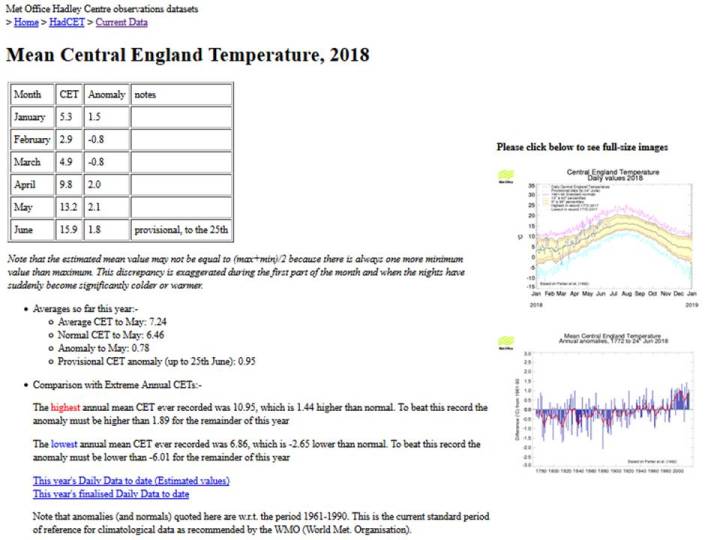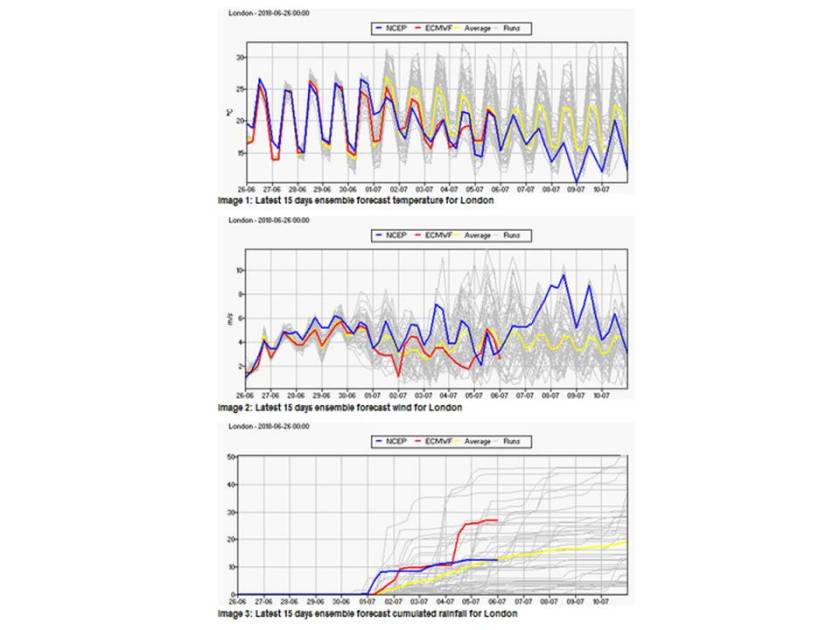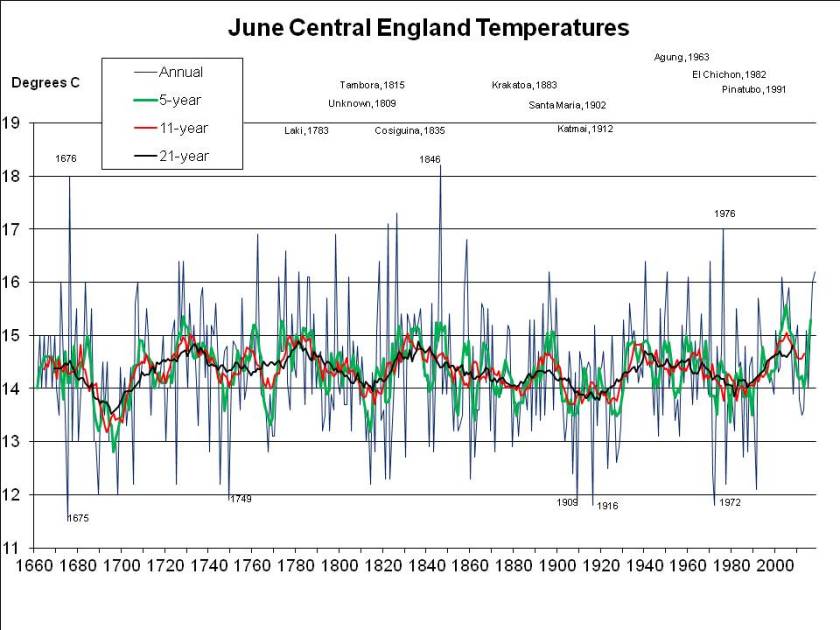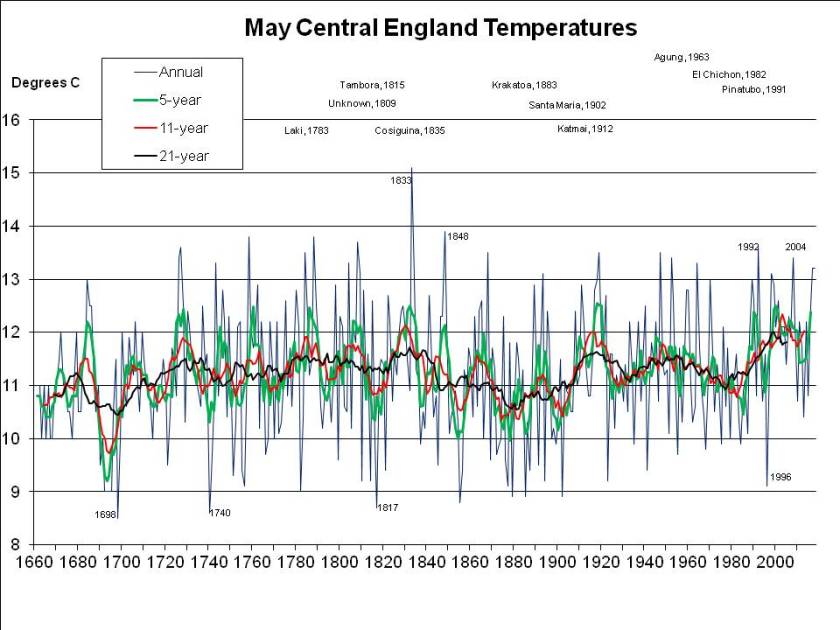It always baffles me that the Met Office reports notable weather months 2 or 3 days before their end – you’d have thought they’d wait to finalise the “official” data – so this time I’m facetiously reporting before they do (assuming I type fast enough)!
I know it’s only the 27th and CET (that’s the Central England Temperature for any newbies) data has been published only up to the 25th (thanks again to the Met Office for this resource):

but it’s already a nailed-on slam-dunk that the CET mean for June 2018 will exceed the 16.1C recorded in the exceptionally hot summer of 2003, making this June the warmest since the legendary summer of 1976 (17C).
I say this simply because the forecast for the rest of the month is for fairly hot conditions to persist (thanks this time to Weathercast):

Simple arithmetic suggests that daily mean temperatures of around 20C (London’s are not atypical of England as a whole, slightly cooler if anything) will drag up the average for the month from 15.9C for the first 25 days to over the 16.1C recorded in 2003. Here’s a graph showing June CET since 1659, assuming (conservatively) a mean of 16.2C this year:

Having said all that, this June and May (which I’ll come to) have not been notable for exceptional temperatures. For example, the current “heatwave”, though fairly unpleasant, has come nowhere near breaking daily records for the CET area (though some local records may be broken, in Wales, for example). Temperatures have so far only edged above 30C in one or two places, with 30.1C at Hampton Water Works on 25th (Monday) not a patch on the 33.5C at East Bergholt on the same date in 1976. Even the 30.7C at Rostherne No 2 yesterday, 26th, is well below 1976’s 35.4C at North Heath.
I might even go so far as to say it’s a little bit of an exaggeration to call the current conditions a “heatwave” (at least in southern England). The term is being devalued by tabloid reporting. It’s an outrage! (To use another overused word). It’s just “hot weather”.
Given that we had several days in succession over 35C in June 1976, and we’ve had 42 years of global warming since then, and warming affects extreme events disproportionately, I wonder what temperatures we’d hit if we had similar conditions to 1976? Presumably then (as in 2003), high pressure didn’t just sit over the UK, but drew in air from the warmest direction in summer, that is from the south-east (or even just from further east).
What has been notable this year has been the persistence of dry, sunny, windless, anticyclonic conditions, with only a small interlude of westerlies in June. That persistent high pressure conditions are fairly unusual in June is presumably the reason why, on average, June CET temperatures have risen less than other months in the global warming era (the black line in the graph above shows that, averaged over 21 years, the recent period has not been exceptional, though global warming will inevitably drag the mean temperature up over the coming decades). Because the oceans warm only slowly, periods of weather dominated by westerlies are likely to be only a little warmer than before global warming set in. The 5 year periods in the mid 2000s and most recently (the green line in the graph) show the potential for generally hotter Junes.
And the historical record (check out 1676 and 1846!), suggests that a truly freakish June these days (with global warming) would average well over 18C, possibly even touching 19C. Much worse than the low 16Cs this year.
At least this June has been reasonably hot. May was widely reported as the hottest and sunniest on record. It was exceptionally sunny (as may also be the case for June), but nowhere near the hottest. Here’s my latest graph of May CET:

In fact, at 13.2C in the CET, May 2018 was only equally as warm as May 2017 and less warm than in 2004 (13.4C), 1992 (13.6C) and quite a few others!
So how can May 2018 be reported as the “hottest on record”?
Well, obviously it might be because statistics are being used for a different region e.g. the UK as a whole, but I don’t think that’s the main reason. The CET is fairly representative.
No, if you read the small print you’ll find that the “hottest May” claim is based on daily maximum temperatures only. When you take night-time temperatures into account, as is almost universal practice, May 2018 was not exceptionally warm. The reason for the difference lies in all that sunny weather, which tends to lead to warm days and cool nights, so that the day-time average temperature is higher than the overall average.
If that weren’t enough, weather record reporting is also afflicted by “Year Zero Syndrome”. The CET record back to 1659 is not used, or even referred to. Instead records are based on the period since 1910, when more comparable records begin. It’s a bit like the way football records in England are now based on the period since the start of the Premier League in 1992, so that we no longer realise that goal-scoring feats comparable (rather than equal, because there are now 2 fewer top-flight teams) to Dixie Dean‘s 60 goals in 1927-28 are still possible. Clearly, from the chart above, no recent May mean temperature approaches that of 1833, or even 1848.
That leads me to my usual warning. May 1833 was about 3.5C hotter at 15.1C than the mean for the period (given by the black 21-year running mean on the graph). Because, in line with global warming, an average May (unlike an average June) is now warmer than at any time since 1659 (the black line again), a similarly freakish May would be somewhere in the mid-15Cs.
Unless the last few years are exceptional, it’s curious that June shows the global warming signal so weakly. I’ll have to look more closely at the data to see if that for any other months exhibits a similar feature.